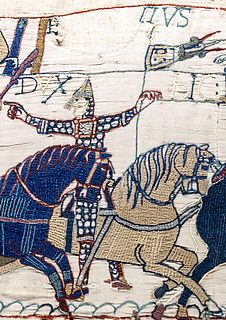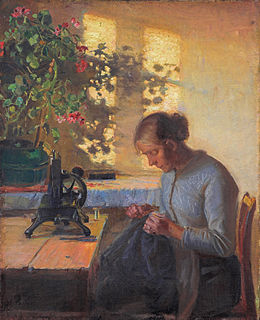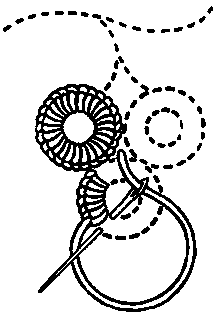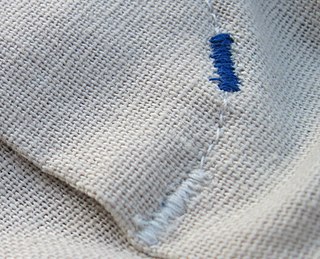Related Research Articles
Bead weaving using seed beads can be done either on a loom or using one of a number of off-loom stitches.

Embroidery is the craft of decorating fabric or other materials using a needle to apply thread or yarn. Embroidery may also incorporate other materials such as pearls, beads, quills, and sequins. In modern days, embroidery is usually seen on caps, hats, coats, overlays, blankets, dress shirts, denim, dresses, stockings, and golf shirts. Embroidery is available in a wide variety of thread or yarn colour.

Knitting is a method by which yarn is manipulated to create a textile, or fabric. It is used to create many types of garments. Knitting may be done by hand or by machine.

Sewing is the craft of fastening or attaching objects using stitches made with a sewing needle and thread. Sewing is one of the oldest of the textile arts, arising in the Paleolithic era. Before the invention of spinning yarn or weaving fabric, archaeologists believe Stone Age people across Europe and Asia sewed fur and leather clothing using bone, antler or ivory sewing-needles and "thread" made of various animal body parts including sinew, catgut, and veins.

Da Afghanistan Bank is the central bank of Afghanistan. It regulates all banking and money handling operations in Afghanistan. The bank currently has 46 branches throughout the country, with five of these situated in Kabul, where the headquarters is also based.

In everyday language, a stitch in the context of embroidery or hand-sewing is defined as the movement of the embroidery needle from the back of the fibre to the front side and back to the back side. The thread stroke on the front side produced by this is also called stitch. In the context of embroidery, an embroidery stitch means one or more stitches that are always executed in the same way, forming a figure. Embroidery stitches are also called stitches for short.

Darning is a sewing technique for repairing holes or worn areas in fabric or knitting using needle and thread alone. It is often done by hand, but it is also possible to darn with a sewing machine. Hand darning employs the darning stitch, a simple running stitch in which the thread is "woven" in rows along the grain of the fabric, with the stitcher reversing direction at the end of each row, and then filling in the framework thus created, as if weaving. Darning is a traditional method for repairing fabric damage or holes that do not run along a seam, and where patching is impractical or would create discomfort for the wearer, such as on the heel of a sock.

Knitted fabric is a textile that results from knitting, the process of inter-looping of yarns or inter-meshing of loops. Its properties are distinct from woven fabric in that it is more flexible and can be more readily constructed into smaller pieces, making it ideal for socks and hats.
The manufacture of textiles is one of the oldest of human technologies. To make textiles, the first requirement is a source of fiber from which a yarn can be made, primarily by spinning. The yarn is processed by knitting or weaving, which turns yarn into cloth. The machine used for weaving is the loom. For decoration, the process of colouring yarn or the finished material is dyeing. For more information of the various steps, see textile manufacturing.

In sewing, bar tack, also written bar-tack or bartack, refers to a series of stitches used to reinforce areas of a garment that may be subject to stress or additional wear. Typical areas for bar tack stitches include pocket openings, buttonholes, belt loops, the bottom of a fly opening, tucks, pleats and the corners of collars. Bar tacks may be sewn by hand, using whip stitches, or by machine, using zigzag stitches. The process for sewing a bar tack is essentially to sew several long, narrowly-spaced stitches along the line of the bar that will be formed, followed by short stitches made perpendicular to the long stitches, through the fabric and over the bar. The bar commonly varies between 1⁄16 to 1⁄8 inch in width and 1⁄4 to 3⁄8 inch in length. In some garments, such as jeans, the bar tack will be sewn in a contrasting color.

The straight or running stitch is the basic stitch in hand-sewing and embroidery, on which all other forms of sewing are based. The stitch is worked by passing the needle in and out of the fabric at a regular distance. All other stitches are created by varying the straight stitch in length, spacing, and direction.
Sewing is the craft of fastening or attaching objects using stitches made with needle and thread. Sewing is one of the oldest of the textile arts, arising in the Paleolithic Era. Although usually associated with clothing and household linens, sewing is used in a variety of crafts and industries, including shoemaking, upholstery, sailmaking, bookbinding and the manufacturing of some kinds of sporting goods. Sewing is the fundamental process underlying a variety of textile arts and crafts, including embroidery, tapestry, quilting, appliqué and patchwork.

The Northern Railroad was a U.S. railroad in central New Hampshire. Originally opened from Concord to West Lebanon in 1847, the Northern Railroad become part of the Boston and Maine system by 1890.
Right-angle weave stitch, also known as RAW, is an off-loom bead weaving technique. Beads are stitched together with thread only making right angle turns, hence the name. The result is an almost fabric like piece of beadwork. Right-angle weave can be woven with either one needle or two. With single needle right-angle weave, the thread path moves in a figure-eight pattern. For double needle right-angle weave, the threads cross each other along the center bead of each stitch as they head in opposite directions. RAW can be formed into flat pieces, tubes, or 3 dimensional figures. There are also variations on the basic stich like cubic right angle weave, or CRAW. Seed beads, fire polished beads and crystal beads are common choices in pieces using right-angle weave. Variations of the right-angle weave also include PRAW. CRAW is usually worked in sets of four, but in PRAW, sets can be expanded to over five.
The Ministry of Planning and Finance administers Burma's monetary, fiscal policies and national planning.
Rantering is a type of stitching made to conceal a seam line that runs across the grain of the joined pieces of fabric. Rantering stitches take hold of the nap of the fabric and pull it closed over the seam. After this process, the tailor will card or scratch the rantering to blend the nap around the seam with the rest of the fabric. A rantering stitch would also be used in the process of mending a garment to conceal seam lines produced in that process.

The hand embroidery machine is a manually operated embroidery machine. It was widely used in the Swiss embroidery industry during the late nineteenth and early twentieth centuries. It was also used in the lace industry near Plauen, Germany, and it played a role in the development of the embroidery industry centered in Hudson County, New Jersey during the early 20th century.

The 120th Massachusetts General Court, consisting of the Massachusetts Senate and the Massachusetts House of Representatives, met in 1899 during the governorship of Roger Wolcott. George Edwin Smith served as president of the Senate and John L. Bates served as speaker of the House.

Minister of Economy of Fiji is heading the ministry of economy in Fiji.
References
- ↑ The Boy's Book of Trades and the Tools Used in Them. London: Routledge. 1866. pp. 218–220. hdl:2027/uiuc.1758057_001 . Retrieved February 6, 2016– via HathiTrust.

- 1 2 Waisman, Abraham (1953). Clever Weave: The Modern method of French Reweaving. Chicago: CleverWeave Publishers. pp. 36–38. hdl:2027/coo.31924003592452 . Retrieved February 6, 2016– via HathiTrust.

- ↑ The New Dressmaker (3rd ed.). New York: Butterick Publishing Co. 1921. p. 148. hdl:2027/loc.ark:/13960/t7dr3c302 . Retrieved February 6, 2016– via HathiTrust.

- ↑ Ryan, Mildred Graves (1954). Thrift with a Needle: The Complete Book of Mending. New York: Charles Scribner's Sons. p. 66. hdl:2027/coo.31924003594474 . Retrieved February 6, 2016– via HathiTrust.

- ↑ Blackmore, Betsy L. (1906). The A-B-C of Needlework. London: Ralph, Holland & Co. pp. 119–120. Retrieved February 6, 2016– via Google Books.

- ↑ Rathvon, S. S. (June 1902). "Technical Terms of Tailoring". The American Tailor and Cutter. New York: Jno. J. Mitchell Co. 23 (12): 343. Retrieved February 6, 2016– via Google Books.

- ↑ Scott, Clarice L. (October 1946). Make-Overs from Leather, Fur and Felt. Washington, D.C.: United States Department of Agriculture. p. 5. Retrieved February 6, 2016– via Google Books.
